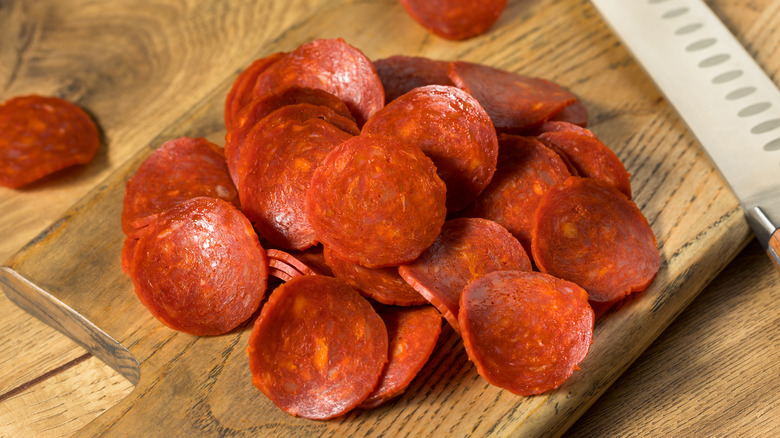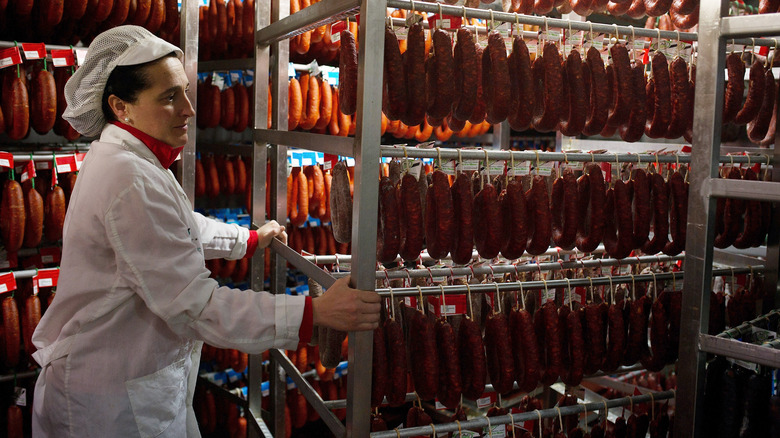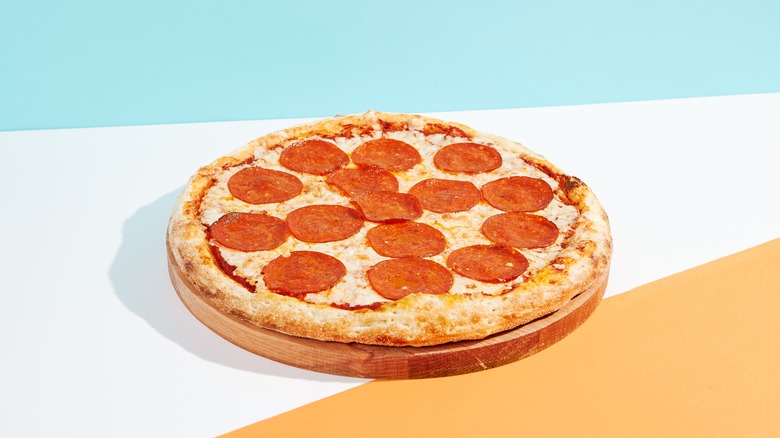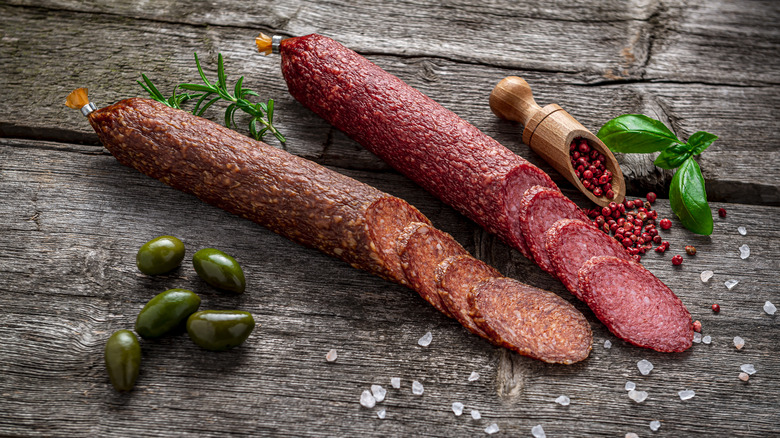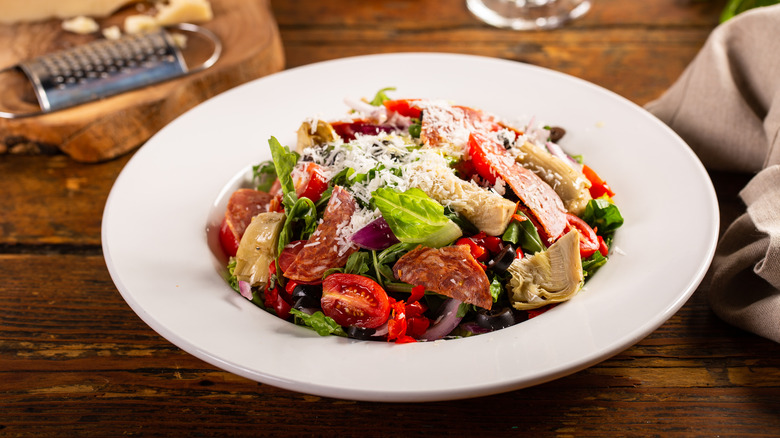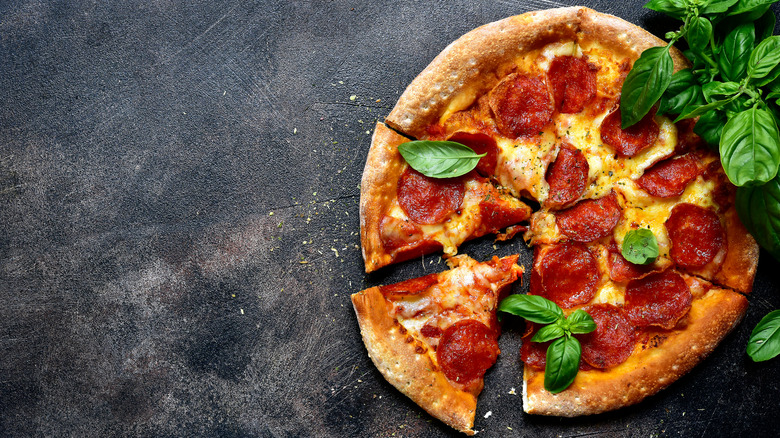Old World Pepperoni Might Not Actually Be What You Expect
We may receive a commission on purchases made from links.
When we're talking history, the old world refers to Europe, Africa, and Asia, while the new world means North America, South America, and the Caribbean. But when we're talking food, the terms "old world" and "new world" may apply to pepperoni instead. The little slices that we know in the United States — aka the ones we typically pile on our pizza — are considered the new world version, although of course we don't call them that. They were invented as late as 1919 by Italian immigrants in New York City and didn't become a classic American pizza topping until the 1950s. In fact, the first pizza to feature this type of pepperoni was in Connecticut.
But pepperoni has been around much longer than the early 20th century — it was just a different type before it caught on in the U.S. Old world pepperoni comes from Italy and it has been around since the 11th century. You can still top your pizza with it, but it can be used in a few other ways and possesses key differences in taste and texture from the more familiar American version. Plus, it's technically a variety of sausage instead of a traditional pepperoni. Let's find out what the motherland does differently than the U.S. so you can decide if you'd like to try this old world meat.
What is old world pepperoni?
Old world pepperoni contains cured pork and beef, which stems from the Sicilians' choice of meat in the Middle Ages. Back then, pork fat was scarce, so the Italians cured it with salt to make it into pepperoni. Despite the mixed meats, however, old world pepperoni was originally an adaptation of the ground pork in Italian salami. It also typically includes a mixture of spices like black pepper and mustard seed, herbs like rosemary and thyme, and garlic, which is also a quality inherited from traditional Italian salami.
Old world pepperoni typically has a more rustic appearance than what we're used to in the States. It may be a mixed bag of shapes, not necessarily a perfect circle, and it's generally thick with a burnt red hue. A signature feature of the sausage slices is that the edges will curl up after being cooked, which happens because the casings react with high heat. So if you see them on a pizza, they'll likely look more like tiny bowls than flat slices.
How is old world pepperoni made?
Another defining quality of old world pepperoni is the natural casing that it's kept in. It's typically made from sheep or pork intestine (which is what reacts with the high oven heat to make it curl) and turns moldy on the outside as the pepperoni is cured (don't worry, it's still okay to eat). This version of the sausage can be cured in a few ways, one of which is using traditional Italian methods. Typically, this means it undergoes a fermentation process in a salt brine, which can take up to a few months to complete. Salt, sugar, and nitrate are added to the sausage so that "good" bacteria (which brings the flavor) can develop.
However, sometimes the meat is cured using extrusion, which is a more synthetic process. In this case, a machine adds a thin layer of gel to coat the sausage right before it lands in a salty solution. The gel then becomes firm enough to form a casing over the meat, and then the long rope of sausage gets cut into smaller bits by another machine. These casings are typically made from collagen, although alginate (a brown seaweed derivative) is sometimes used too. Finally, the pepperoni is dried, heated, and blasted with liquid smoke to seal its color and flavor.
Old world vs. American pepperoni
Now that you know what makes old world pepperoni distinct, let's take a look at what separates it from its American counterpart — aka, the pepperoni most of us are used to eating in the States. Unlike the old world version, our pizza topping here is usually made from lean pork and beef. It typically doesn't have all the additional seasonings and spices and contains less than 20% fat, while old world sausage can be up to half pork fat. Pepperoni made in the U.S. also usually has a synthetic casing and tends to be more processed, which means that when it's sliced, it's usually thinner and softer.
When comparing color and taste, you'll find a stronger flavor in the Italian meat due to the bacteria and seasonings it's made with. However, American pepperoni can be spicier than the old world stuff — and in line with many foods in the U.S., it tends to have more added sugar, giving it an overall sweeter taste. It will often appear lighter in color as well, leaning more toward a light red or red-orange than the crimson hues of the Italian type.
What does old world pepperoni taste like?
We already know that old world pepperoni has a stronger flavor than the American stuff — but what exactly does it taste like? Since it curls up easily in the oven, it'll have more of a crunch and a bit of char, which can give the cooked meat slight bacon flavors. Compared to U.S. pepperoni, it will have a smokier taste. It will also, of course, have notes of whatever spices it's cooked with, and all of these flavors are usually enhanced due to the fermentation involved in the natural curing process. In addition to the seasonings previously mentioned, old world pepperoni is sometimes made with fennel, paprika, and chili peppers. The exact taste of the sausage can vary since different ones are made with different flavors.
Due to the thicker texture of the meat and the minimal processing, the Italian version doesn't fall apart easily, so you're getting a (literally) meatier product. It tends to be firmer and has more of a bite to it, with the signature crispy edges. In rarer cases, you may see it sliced a little thinner, although the bold flavor will remain intact.
How to cook with old world pepperoni
The obvious way to cook with old world pepperoni, of course, is to put it on pizza. Some people remove the casing first if they don't like the idea of a crispier-edged meat that curls when cooked, but you don't have to. You'd add it to your homemade pizza just like you would American pepperoni — on top of your cheese and with your other toppings. But first, try nuking it in the microwave on a paper towel for half a minute so it will be a little undercooked going into the oven and ready to crisp up.
There's a plethora of additional ways to use it — in short, any dish that you would cook with American pepperoni would be a great place to substitute its thicker, more flavorful brother. Try adding it to sandwiches (or the Hailey Bieber-famous pizza toast), paninis, charcuterie boards, and antipasti salads, or use it to make yummy apps like pizza rolls and bites. Since it has notes of bacon, you may want to include old world pepperoni in pasta recipes where the flavors would be complimentary, like a carbonara. And because it has a potent, smoky, meaty flavor, it can be used in dishes that are a little overly sweet to balance everything out (like tomato-based pasta, for example).
Where to buy old world pepperoni
This type of pepperoni may have originally come from the old world, but that doesn't mean you can't find it in the new world too. In fact, the Unites States Food and Drug Administration approved importing Italian pepperoni in the U.S. as early as 1963. If you have the time, try looking at Italian specialty shops where you may be able to find it in whole sausage links and pre-sliced packages. If you're looking for it already pressed onto a pizza, try searching local shops in your area — for example, Samosky's Homestyle Pizzeria in Ohio sells an Old World Pepperoni pie with "old-world & traditional pepperoni."
If you're just looking for the meat, however, major retailers like Walmart and Kroger are likely to have it. If you're not having any luck with stores near you, try Amazon – they have a selection of old world pepperoni sticks and slices. And when in doubt, head straight to brands' websites that make it, like Ezzo Sausage Company. It's important to note that there is no official stamp of approval to differentiate old world pepperoni from the rest, so try to find packages that say they make it specifically. If you're not finding those words, look for slices that have the qualities we've mentioned and that curl up in the oven.
Nutritional information about old world pepperoni
The nutritional information for old world pepperoni will differ slightly by brand, but in general, you can count on the meat to have part of your daily protein. A serving of six slices of Private Selection Old World Pepperoni and a serving of 28 grams of the Roundy's brand have 5 grams of protein, which is 10% of your daily value. As with many cured meats, there's also typically quite a bit of sodium in this type of sausage — the same amount of the Private Selection brand, for example, has 540 milligrams. Some of these meats may also have small amounts of iron, sugar, and vitamin A.
Old world pepperoni also tends to have a bit of fat (12 grams in a serving of Roundy's) and saturated fat (five grams). According to Healthline, eating too much saturated fat can lead to an increased risk of heart disease, higher cholesterol, and increased inflammation, although more research needs to be done to form solid conclusions. Also, the World Health Organization recommends that adults eat less than 2,000 milligrams of sodium per day since overdoing it can raise blood pressure and increase your risk of heart disease and stroke. If you're excited about the idea of trying the old world version of pepperoni, don't let these numbers stop you, but you may want to keep them in mind if the meat becomes a staple in your diet.
